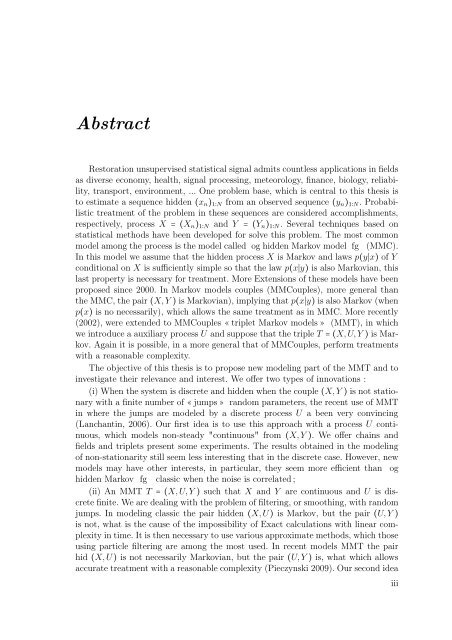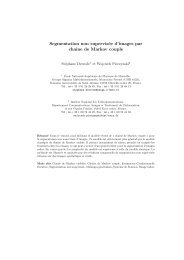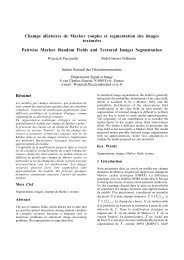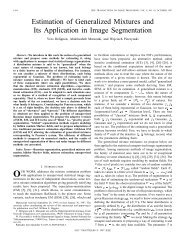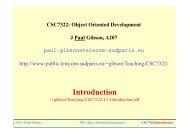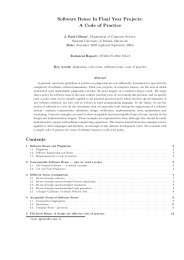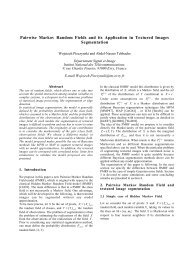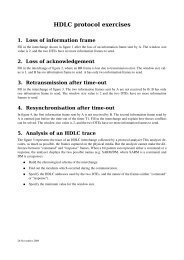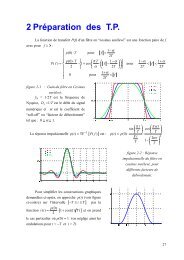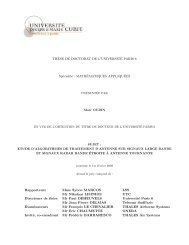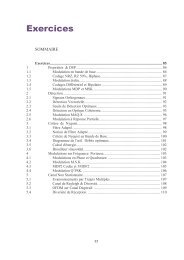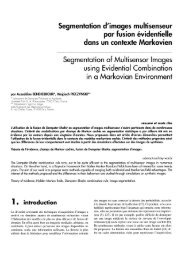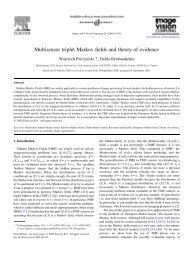Modèles de Markov triplets en restauration des signaux
Modèles de Markov triplets en restauration des signaux
Modèles de Markov triplets en restauration des signaux
Create successful ePaper yourself
Turn your PDF publications into a flip-book with our unique Google optimized e-Paper software.
AbstractRestoration unsupervised statistical signal admits countless applications in fieldsas diverse economy, health, signal processing, meteorology, finance, biology, reliability,transport, <strong>en</strong>vironm<strong>en</strong>t, ... One problem base, which is c<strong>en</strong>tral to this thesis isto estimate a sequ<strong>en</strong>ce hid<strong>de</strong>n(x n ) 1∶N from an observed sequ<strong>en</strong>ce(y n ) 1∶N . Probabilistictreatm<strong>en</strong>t of the problem in these sequ<strong>en</strong>ces are consi<strong>de</strong>red accomplishm<strong>en</strong>ts,respectively, process X =(X n ) 1∶N and Y =(Y n ) 1∶N . Several techniques based onstatistical methods have be<strong>en</strong> <strong>de</strong>veloped for solve this problem. The most commonmo<strong>de</strong>l among the process is the mo<strong>de</strong>l called og hid<strong>de</strong>n <strong>Markov</strong> mo<strong>de</strong>l fg (MMC).In this mo<strong>de</strong>l we assume that the hid<strong>de</strong>n process X is <strong>Markov</strong> and laws p(y∣x) of Yconditional on X is suffici<strong>en</strong>tly simple so that the law p(x∣y) is also <strong>Markov</strong>ian, thislast property is necessary for treatm<strong>en</strong>t. More Ext<strong>en</strong>sions of these mo<strong>de</strong>ls have be<strong>en</strong>proposed since 2000. In <strong>Markov</strong> mo<strong>de</strong>ls couples (MMCouples), more g<strong>en</strong>eral thanthe MMC, the pair(X,Y) is <strong>Markov</strong>ian), implying that p(x∣y) is also <strong>Markov</strong> (wh<strong>en</strong>p(x) is no necessarily), which allows the same treatm<strong>en</strong>t as in MMC. More rec<strong>en</strong>tly(2002), were ext<strong>en</strong><strong>de</strong>d to MMCouples « triplet <strong>Markov</strong> mo<strong>de</strong>ls » (MMT), in whichwe introduce a auxiliary process U and suppose that the triple T=(X,U,Y) is <strong>Markov</strong>.Again it is possible, in a more g<strong>en</strong>eral that of MMCouples, perform treatm<strong>en</strong>tswith a reasonable complexity.The objective of this thesis is to propose new mo<strong>de</strong>ling part of the MMT and toinvestigate their relevance and interest. We offer two types of innovations :(i) Wh<strong>en</strong> the system is discrete and hid<strong>de</strong>n wh<strong>en</strong> the couple(X,Y) is not stationarywith a finite number of « jumps » random parameters, the rec<strong>en</strong>t use of MMTin where the jumps are mo<strong>de</strong>led by a discrete process U a be<strong>en</strong> very convincing(Lanchantin, 2006). Our first i<strong>de</strong>a is to use this approach with a process U continuous,which mo<strong>de</strong>ls non-steady "continuous" from(X,Y). We offer chains andfields and <strong>triplets</strong> pres<strong>en</strong>t some experim<strong>en</strong>ts. The results obtained in the mo<strong>de</strong>lingof non-stationarity still seem less interesting that in the discrete case. However, newmo<strong>de</strong>ls may have other interests, in particular, they seem more effici<strong>en</strong>t than oghid<strong>de</strong>n <strong>Markov</strong> fg classic wh<strong>en</strong> the noise is correlated;(ii) An MMT T=(X,U,Y) such that X and Y are continuous and U is discretefinite. We are <strong>de</strong>aling with the problem of filtering, or smoothing, with randomjumps. In mo<strong>de</strong>ling classic the pair hid<strong>de</strong>n(X,U) is <strong>Markov</strong>, but the pair(U,Y)is not, what is the cause of the impossibility of Exact calculations with linear complexityin time. It is th<strong>en</strong> necessary to use various approximate methods, which thoseusing particle filtering are among the most used. In rec<strong>en</strong>t mo<strong>de</strong>ls MMT the pairhid(X,U) is not necessarily <strong>Markov</strong>ian, but the pair(U,Y) is, what which allowsaccurate treatm<strong>en</strong>t with a reasonable complexity (Pieczynski 2009). Our second i<strong>de</strong>aiii


